
The Tordrillo Mountains are a small mountain range in the Matanuska-Susitna and Kenai Peninsula Boroughs in the southcentral region of the U.S. state of Alaska. They lie approximately 75 miles (121 km) west-northwest of Anchorage. The range extends approximately 60 miles (97 km) north-south and 35 miles (56 km) east-west. The highest point is Mount Torbert. On a clear day, they are easily visible from Anchorage.

Mount Johnson is an 8,400+ ft mountain summit located in the Alaska Range, in Denali National Park and Preserve, in Alaska, United States. It is situated on the west side of the Ruth Gorge, 15 miles (24 km) southeast of Denali and six miles (9.7 km) south-southwest of The Moose's Tooth. The nearest higher neighbor is Mount Wake, 0.69 miles (1.11 km) to the northwest.

Mount Barrille is a 7,650 ft (2,330 m) mountain summit located in the Alaska Range, in Denali National Park and Preserve, in the U.S. state of Alaska. It is situated 2,650 feet above the Ruth Glacier at the gateway to the Don Sheldon Amphitheater, or The Great Gorge, depending on direction of travel. Barrille is set 11.43 mi (18 km) southeast of Denali, 3.37 mi (5 km) west of The Mooses Tooth, 3.68 mi (6 km) east of The Rooster Comb, and 1.42 mi (2 km) north of Mount Dickey which is the nearest higher peak. The mountain was named by famed explorer Dr. Frederick Cook for Edward Barrill (1861–1946), a horse packer from Darby, Montana, who was his sole companion during his 1906 claim to be the first to climb Denali. The claim was later disproved, and in 1909 Barrill signed an affidavit stating that they had not reached the summit. Cook referred to his companion as Barrille in his accounts of the expedition, and Barrille remains as the official spelling used by the United States Geological Survey.
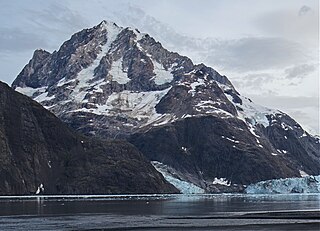
Mount Abbe is an 8200+ feet double summit mountain located in the Fairweather Range of the Saint Elias Mountains, in southeast Alaska. The peak is situated near the terminus of the Johns Hopkins Glacier, within Glacier Bay National Park and Preserve, 100 mi (161 km) northwest of Juneau, and 8.2 mi (13 km) northeast of Mount Orville. Although modest in elevation, relief is significant since the mountain rises up from tidewater in less than two miles. Mount Abbe is often seen and photographed with the Johns Hopkins Glacier, which is a popular destination for cruise ships. The mountain was named in 1936 by William Osgood Field and William Skinner Cooper, of the American Geographical Society, for Cleveland Abbe Jr., (1872-1934), an American geographer. Abbe received a Ph.D. in 1898 from Johns Hopkins University. The Gilman Glacier and Clark Glacier on the mountain's slopes were named for Daniel Coit Gilman, the institution's first president, and William Bullock Clark who was a professor of geology at the university. The mountain's name was officially adopted in 1937 by the United States Geological Survey. The first ascent of the south summit was made June 11, 1977, by Jim Wickwire and Dusan Jagersky via the Southeast Face. Three days later, Dusan Jagersky was killed while descending an unnamed peak. The first ascent of the north summit was made July 14, 1991, by Walter Gove and William Pilling. The months May through June offer the most favorable weather for climbing Mount Abbe, but it's a challenging climb in any conditions, with few attempts.
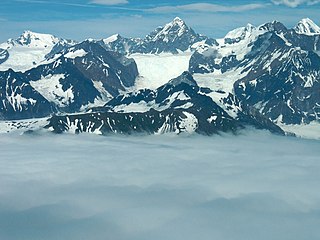
Mount Watson is a 12,497-foot glaciated mountain summit located in the Fairweather Range of the Saint Elias Mountains, in southeast Alaska, United States. It ranks as the fifth-highest peak in the Fairweather Range. The peak is situated in Glacier Bay National Park, 2 mi (3 km) west of the Canada–United States border, and 7.16 mi (12 km) north of Mount Fairweather, which is the highest peak in the Fairweather Range. The mountain's name was officially adopted by the United States Board on Geographic Names in 1924 to commemorate David Thompson Watson (1844-1916), who was US Counsel to the 1903 Alaska Boundary Tribunal. The first ascent of the peak was made June 18, 1974, by Michael Allen, Walter Gove, Lawrence Dauelsberg, Alice Liska, and Donald Liska via the East Ridge. The first ascent of the North Face was made in April 1999 by Chris Trimble and Jim Earl. The months May through June offer the most favorable weather for climbing.

Mount La Perouse is a 10,728-foot glaciated mountain summit located in the Fairweather Range of the Saint Elias Mountains, in southeast Alaska, United States. The peak is situated in Glacier Bay National Park, 4 mi (6 km) southeast of Mount Dagelet, 7.6 mi (12 km) south-southeast of Mount Crillon which is the nearest higher peak, and 28.6 mi (46 km) southeast of Mount Fairweather, which is the highest peak in the Fairweather Range. Topographic relief is significant as the mountain rises up from tidewater in less than nine miles. The mountain was named in 1874 by William Healey Dall of the U.S. Geological Survey, for Jean-François de Galaup, comte de Lapérouse (1741–1788), a French navigator who explored this coastal area in 1786. The first ascent of the peak was made in 1953 by USGS party consisting of James Seitz, Karl Stauffer, Rowland Tabor, Rolland Reid, and Paul Bowen. On February 16, 2014, a colossal 68 million ton landslide broke free from the flanks of Mt. La Perouse and flowed nearly 4.6 miles from where it originated. The months May through June offer the most favorable weather for climbing and viewing.
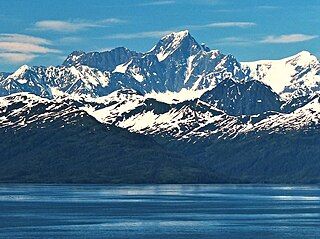
Mount Gilbert is a prominent 9,638-foot (2,938 m) glaciated mountain summit located in the Chugach Mountains, in the U.S. state of Alaska. The peak is situated 54 mi (87 km) east of Anchorage, 32 mi (51 km) northeast of Whittier, and 5.8 mi (9 km) northeast of Mount Muir, on land managed by Chugach National Forest. Although modest in elevation, relief is significant since the mountain rises up from tidewater at Harriman Fjord in Prince William Sound in less than six miles.

Mount Tom White is a prominent 11,191-foot glaciated mountain summit located in the Chugach Mountains, in the U.S. state of Alaska. The remote peak is situated on land managed by Chugach National Forest, 72 mi (116 km) northeast of Cordova, and 20 mi (32 km) north of the Bering Glacier, North America's largest glacier. The mountain lies within the Copper River drainage basin, and is the eighth-highest major peak in the Chugach Mountains. Topographic relief is significant as it ranks 17th in prominence for all peaks in Alaska, and 52nd for all North America peaks. The first ascent of the mountain was made in 1973 by Story Clark, Chris Hall, Tom Kizzia, William Resor, Sarah Robey, and Don White.

Mount Huxley is a 12,216-foot glaciated mountain summit located in the Saint Elias Mountains of Wrangell-St. Elias National Park and Preserve, in the U.S. state of Alaska. The remote peak is situated 75 mi (121 km) northwest of Yakutat, and 8.7 mi (14 km) west-northwest of Mount Saint Elias. The peak rises above the Columbus Glacier and Bagley Icefield to its north, the Tyndall Glacier to the south, and the Yahtse Glacier to the west. Precipitation runoff from the mountain drains into the Gulf of Alaska. The mountain was named in 1886 by English mountaineer Harold Ward Topham for Thomas Henry Huxley (1825-1895), an English biologist. The mountain was officially named Huxley Peak in 1917, but the name was officially changed to Mount Huxley in 1968 by the U.S. Board on Geographic Names. The first ascent of the peak was made June 9, 1996 by Paul Claus who landed his plane at 11,500 feet elevation on the western flank and climbed the remaining distance to the summit. The second ascent of Mt. Huxley, and first complete ascent from base to summit, was made in June 2018 by Scott Peters, Andrew Peter, and Ben Iwrey starting from the Columbus Glacier.
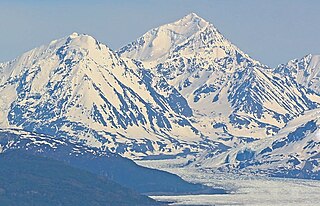
Mount Goode, pronounced like "good", is a prominent 10,610-foot (3,234 m) glaciated mountain summit located in the Chugach Mountains, in the U.S. state of Alaska. The peak is situated 60 mi (97 km) east of Anchorage, 10 mi (16 km) northwest of College Fjord, 3.35 mi (5 km) west of Mount Grace, and 10.9 mi (18 km) southwest of Mount Marcus Baker, on land managed by Chugach National Forest.

Mount Nagishlamina is an 11,068-foot glaciated mountain summit located in the Tordrillo Mountains of the Alaska Range, in the US state of Alaska. The mountain is situated 90 mi (145 km) west of Anchorage, 7.4 mi (12 km) northwest of Mount Spurr, and 1.9 mi (3 km) southeast of Mount Torbert, which is the nearest higher neighbor. It is the fifth-highest peak in the Tordrillo Mountains, a subset of the Alaska Range. The mountain takes its Denaʼina language name from the Nagishlamina River which drains the west side of the peak. Mount Nagishlamina's name was in use by local mountaineers since the 1970s, and was officially adopted in 1999 by the U.S. Board on Geographic Names. This geographic feature was likely the highest unclimbed peak in the United States at the time of its first ascent in 1989 by Dave Johnston.
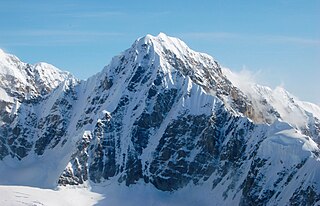
Kahiltna Queen is a 12,380-foot-elevation (3,773-meter) mountain summit in the U.S. state of Alaska.

Mount Emmerich is a 6,877-foot-elevation (2,096-meter) mountain summit in Alaska.
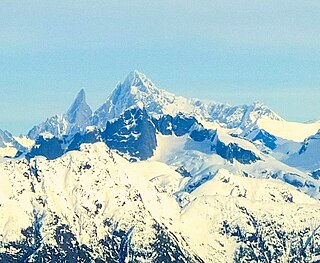
Mount Burkett is a 9,730-foot-elevation (2,966-meter) mountain summit in Alaska, United States.
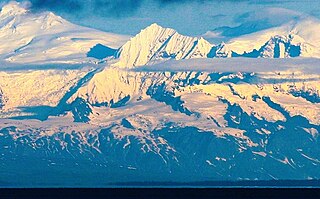
The Rowel is a 9,806-foot-elevation (2,989-meter) mountain summit in Alaska.

Mount Chichantna is a 10,893-foot-elevation (3,320-meter) mountain summit in Alaska.

Paradise Peak is a 6,050-foot-elevation (1,844-meter) mountain summit in Alaska, United States.

Mount Bagot is a 2,181-metre (7,156-foot) mountain summit located on, and in part defining, the international border between British Columbia, Canada, and Alaska, United States.

Mount Geist is a 10,716-foot-elevation (3,266-meter) mountain summit in Alaska, United States.

Mount Adolph Knopf is a 6,200-foot-elevation (1,890-meter) glaciated mountain summit located in the Boundary Ranges of the Coast Mountains, in the U.S. state of Alaska. It is situated 28 miles (45 km) north-northwest of Juneau to the western side of the Juneau Icefield, on land managed by Tongass National Forest. Topographic relief is significant as the summit rises 2,200 feet (670 m) above the Eagle Glacier in 0.5 mi (0.80 km) and 3,800 feet (1,158 m) above the Thiel Glacier in 1.25 mi (2.01 km). Precipitation runoff from the mountain's slopes drains to Lynn Canal.























